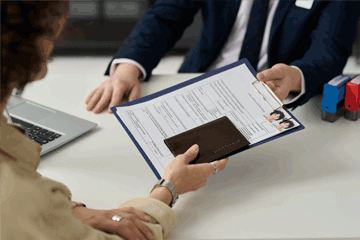If the thought of roaming charges fills you with dread, don't worry. An eSIM might be the perfect solution for your travels. These eSIMs work with most new smartphones. You don't need to go out and buy a physical card. You can just install it from the comfort of your home.
Here's a breakdown of what you need to know about eSIMs, including how they work, setting them up, and where they can be used.

What is an eSIM?
An eSIM is a digital alternative to the traditional SIM card.
They work the same as the physical SIM card on your mobile phone, and are an affordable and quick way to access data while travelling. Here's some of the main benefit eSIMs offer:
- They can help save money on expensive roaming costs. Once activated, your eSIM can be used to access a local network provider at a potentially cheaper rate than your current UK network's roaming price.
- There's no hassle of inserting a physical SIM. Rather than having to set a new physical SIM up, you'll be able to easily add your eSIM to your phone. Usually, this is through an app, QR code, or email.
- They provide plenty of flexibility. eSIMs make it easy to switch network providers and plans, so you'll be able to toggle your eSIM on and off when needed.
How do I activate an eSIM before I travel?
An eSIM is activated on a phone using wifi or mobile data.
Some eSIMs need to be activated it in the UK, but others might need to be activated at your holiday destination. Check this before you travel so you have no issues getting online.
Keep in mind that certain eSIMs can also come with a QR code. If this is the case for you, you'll need to scan it on your phone and then follow the steps on screen to activate it.
If you buy travel insurance through us, you'll receive a free eSIM with up to 2GB of roaming data* as a reward. You'll also get helpful instructions on how to get it activated for your trip, too. Boom.
Tip: Planning to use your eSIM for your holiday? Make sure to set it as default so you're not using your normal data allowance.
*eSIM comes with pre-funded credit and the amount of data received in exchange, will vary based on the specific country you select. Compatible devices only. T&Cs apply.
Where can I use my eSIM when I'm on holiday?
This depends on what type of eSIM you have, and whether there's any restrictions on where it can be used.
If you're travelling to Europe, most UK network providers allow you to use your regular data and minutes once in the European Union (EU). This isn't always the case, so check the details of your plan if you're considering this option.
But once abroad, UK network provider roaming speeds can often be slow. So, you might find making calls and using the internet tricky through your usual plan.
eSIMs are ideal because they're able to access local networks once they've been activated. This means that, once you've reached your European destination, using an eSIM could give you a faster online experience.
If you're planning to travel elsewhere in the world, roaming costs outside of the EU can skyrocket. This includes places like Africa, Asia, South America and North America. So, it could be more affordable to use an eSIM than a daily allowance on your normal SIM.
Remember, while there are some eSIMs that offer unlimited data over a set timeframe, many come with a mobile data limit. After it's been reached, you'll need to pay for any extra data you may need.
What happens if my eSIM runs out of data while I'm on holiday?
If you run out of data and need more, all you'll need to do is top your eSIM up with additional data. Sorted!
Most eSIMs are operated through an app, so any add-on data you may need can be conveniently purchased through them.
But this can come at an extra cost, and the amount can vary depending on where you're located and how much data you need.
Before topping up your eSIM data, check the price to avoid unexpected costs and get back online smoothly.
Is my phone compatible with an eSIM?
Not all devices are compatible with eSIMs, but many modern smartphones should be eSIM compatible.
If you have an Apple device, anything released from the iPhone XS in 2018 should be eSIM compatible. Newer Samsung and Google Pixel devices should also work, but older phones might still use a physical SIM.
The easiest way to find out if your device supports an eSIM is to check on your phone manufacturer's website.








